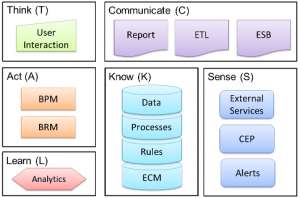Cognitive Corporation™ Innovation Lab Kickoff!
Friday, August 10th, 2012I am excited to share the news that Blue Slate Solutions has kicked off a formal innovation program, creating a lab environment which will leverage the Cognitive Corporation™ framework and apply it to a suite of processes, tools and techniques. The lab will use a broad set of enterprise technologies, applying the learning organization concepts implicit in the Cognitive Corporation’s™ feedback loop.
I’ve blogged a couple of times (see references at the end of this blog entry) about the Cognitive Corporation™. The depiction has changed slightly but the fundamentals of the framework are unchanged.
 The focus is to create a learning enterprise, where the learning is built into the system integrations and interactions. Enterprises have been investing in these individual components for several years; however they have not truly been integrating them in a way to promote learning.
The focus is to create a learning enterprise, where the learning is built into the system integrations and interactions. Enterprises have been investing in these individual components for several years; however they have not truly been integrating them in a way to promote learning.
By “integrating” I mean allowing the system to understand the meaning of the data being passed between them. Creating a screen in a workflow (BPM) system that presents data from a database to a user is not “integration” in my opinion. It is simply passing data around. This prevents the enterprise ecosystem (all the components) from working together and collectively learning.
I liken such connections to my taking a hand-written note in a foreign language, which I don’t understand, and typing the text into an email for someone who does understand the original language. Sure, the recipient can read it, but I, representing the workflow tool passing the information from database (note) to screen (email) in this case, have no idea what the data means and cannot possibly participate in learning from it. Integration requires understanding. Understanding requires defined and agreed-upon semantics.
This is just one of the Cognitive Corporation™ concepts that we will be exploring in the lab environment. We will also be looking at the value of these technologies within different horizontal and vertical domains. Given our expertise in healthcare, finance and insurance, our team is well positioned to use the lab to explore the use of learning BPM in many contexts.